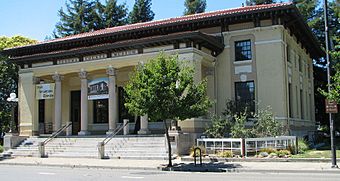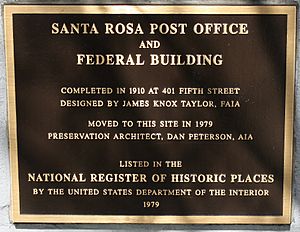Museum of Sonoma County facts for kids
Quick facts for kids |
|
|
Old Post Office
|
|

Museum of Sonoma County
|
|
| Location | 425 7th St., Santa Rosa, California |
|---|---|
| Area | 0.5 acres (0.2 ha) |
| Built by | Mr. William K. Collier, Superintendent of Construction of Public Buildings Hoyt Brothers (contractor) |
| Architect | Office of the Supervising Architect James Knox Taylor, |
| Architectural style | Roman Renaissance Revival |
| NRHP reference No. | 79000559 |
| Added to NRHP | November 16, 1979 |
The Museum of Sonoma County is a special place in downtown Santa Rosa, California, where you can explore art and history. It's a non-profit organization, which means its main goal is to educate the public, not to make money.
The museum is made up of three parts: a historic post office from 1910, a modern art gallery, and a beautiful sculpture garden. Inside, the museum shows 10 to 12 new exhibits each year. It also has a huge collection of over 18,000 items that tell the story of the area and its artists. The old post office building is so important that it's listed on the National Register of Historic Places.
Contents
History of the Museum
A Grand Post Office for Santa Rosa
Long ago, the Santa Rosa Post Office was located in a simple adobe house. Later, it moved to a theater building. In 1906, the U.S. government decided it was time to build a permanent, grand building for the post office. They set aside $100,000 for the project.
Just one month later, the powerful 1906 earthquake hit, destroying much of downtown Santa Rosa. The post office had to operate out of a grocery store surrounded by rubble. A local businessman urged the government to speed up the construction of the new building.
The government's main architect, James Knox Taylor, designed the new post office. He created a beautiful building in a style called Classic Federal Architecture, which was very popular at the time. Construction began in 1908. Many local companies and workers helped build it, showing great community spirit. The building even had advanced technology for its time, like an automatic oil heating system that also provided hot showers for mail carriers!
On March 9, 1910, the brand-new Santa Rosa Post Office officially opened.
How the Museum Was Saved
Over the years, the main post office moved to a new location. In 1969, another earthquake damaged downtown Santa Rosa. City planners wanted to tear down the historic 1910 post office to build a shopping mall.
But a local architect named Dan Peterson had a brilliant idea to save it. Instead of tearing it down, why not move the entire building? In April 1979, an amazing project began. Workers carefully lifted the huge building onto a set of rails. Using pulleys and cables, they slowly moved the post office. It moved about 36 feet each day until it reached its new home on 7th Street, over 750 feet away!
After the move, Dan Peterson helped restore the building. It reopened in 1985 as the Sonoma County Museum.
Growing and Changing
The museum has continued to grow and change over the years.
- Sculpture Garden: In 2011, a peaceful sculpture garden opened next to the museum for visitors to enjoy outdoor art.
- Art and Expansion: In 2001, a man named Tom Golden donated his collection of art by Christo and Jeanne-Claude. These artists were famous for their huge outdoor projects, like "Running Fence," a 24-mile-long white fabric fence that ran through Sonoma County in the 1970s. In 2015, the museum expanded into a nearby warehouse, creating a new gallery for modern art.
- A New Name: For a while, the museum was known as two separate places: one for art and one for history. In 2018, it changed its name to the Museum of Sonoma County. This change shows that it is one big museum with two buildings, where art and history come together.
What's in the Collection?
The museum's collection has more than 18,000 objects. These items help tell the story of the people, businesses, and lifestyles of the region. The collection celebrates artists who have lived and worked in the area.
Some of the highlights include:
- Christo and Jeanne-Claude: The collection includes 125 drawings, sculptures, and photos from these famous artists.
- Local Artists: You can see beautiful pottery by Marguerite Wildenhain and sculptures by Carroll Barnes.
- Historic Paintings: The museum has landscape paintings of California from the 1800s by artists like Thomas Hill.
- Fountaingrove History: There are objects related to a unique community called Fountaingrove and its leaders, Thomas Lake Harris and Kanaye Nagasawa.
- Chinatown History: The collection includes over 200 photos and items that tell the story of Santa Rosa's historic Chinatown and its community.
See also
- List of United States post offices




